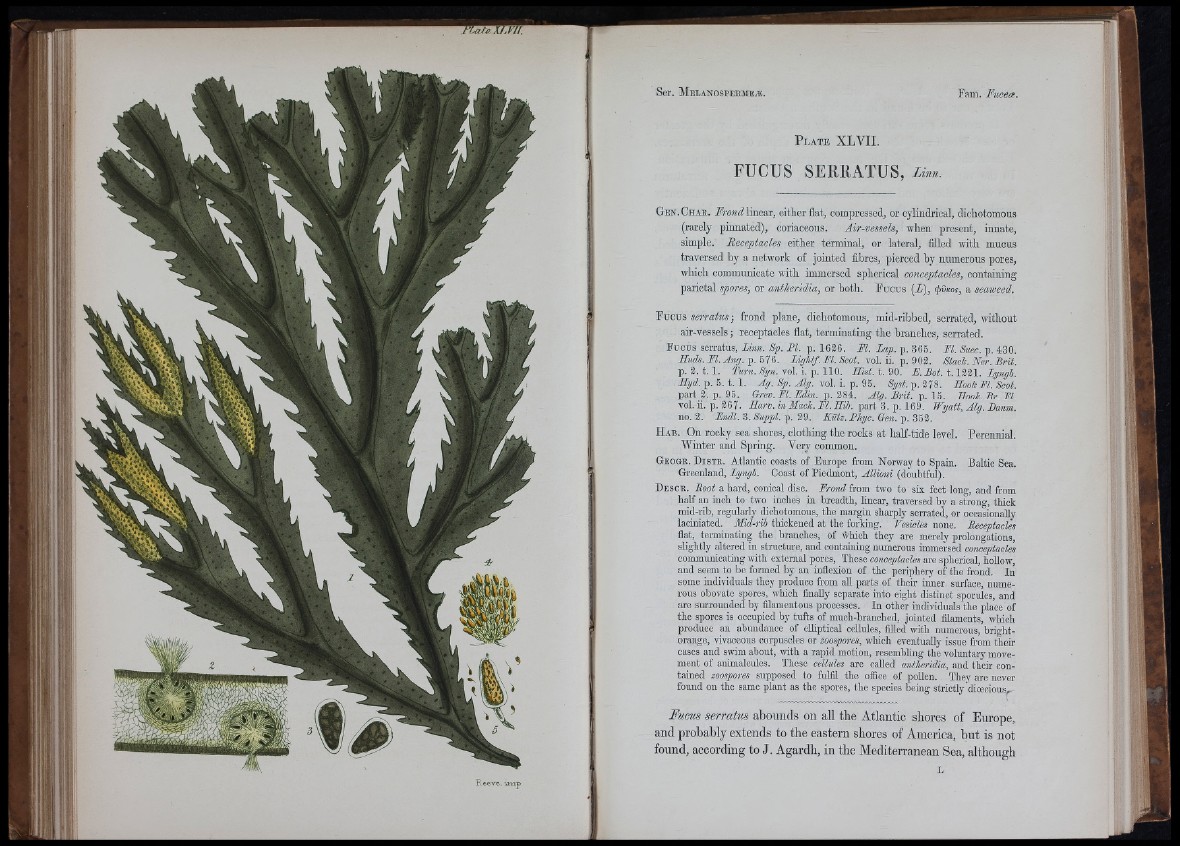
Hce.-v-c, i
P l a t e X L V I I .
FUCUS SERRATUS, Linn.
Gen.Chae. Frondlmawi, either flat, compressed, or cylindrical, dichotomous
(rarely pinnated), coriaceous. Air-vessels, when present, innate,
simple. Receptacles either terminal, or lateral, filled with mucus
traversed by a network of jointed fibres, pierced by numerous pores,
which communicate with immersed spherical conceptacles, containing
parietal spores, or antheridia, or both. F n o u s (L), <j>0/cos, a seaweed.
D w x i, se rratus) frond plane, diohotomous, mid-ribbed, serrated, without
air-vessels; receptacles flat, termina ting th e branches, serrated.
F u cu s serratus, L im . Sp. P I p. 1636. PI. Lap. p. 365. PL Suec. p. 430.
Huds. PI. Ang.-p. 313. Lightf .PI. Scot. vol.ii. p. 903. Stack. Ner. Brit.
p. 3. 1 .1. Turn. Syn. vol. i. p. 110. Hist, t, 90. P. Bot. 1 .1331. Lyngb.
Hyd. p. 3. t . l . Ag. Sp. Alg. v o l.i. p .9 3 . Sgst.p.21%. Hook PI. Scot.
part 3. p. 95. Oi-ev. PI. Edin. p. 384. Alg. Brit. p. 15. Hook. Br. PL
vol. ii. p. 367. Harv. in Mack. PL Hib. part 3. p. 169. Wyatt, Alg. Banm.
no. 3. Endl. 3. Suppl. p. 39. Kiitz. Phyc. Gen. p. 353.
H ab. On rocky sea shores, clothing the rocks at half-tide level. Perennial.
W in te r and Spring. Very common.
G e o g e . D i s t k . Atlantic coasts of Em-ope from Norway to Spain. Baltic Sea.
Greenland, Lyngb. Coast of Piedmont, Allioni (doubtful).
D e s c b . Boot a hard, conical disc. Erond from two to six feet long, and from
half an inch to two inches in breadth, linear, traversed by a strong, thick
mid-rib, reg-ularly dichotomous, the margin sharply serrated, or occasionally
laciniated. Mid-rib thickened at the forking. Vesicles none. Beceptacles
flat, terminating the branches, of -which they are merely prolongations,
slightly altered in structure, and containing numerous immersed conceptacles
communicating- with external pores, These conceptacles are spherical, hollow,
and seem to be formed by an inflexion of the periphery of the frond. In
some individuals they produce from all parts of then- inner surface, numerous
obovate spores, which finally separate into eight distinct sporides, aud
are sm-rounded by filamentous processes. In other individuals the place of
the spores is occupied by tufts of much-branched, jointed filaments, which
produce an abundance of elliptical cellules, filled -with numerous, bright-
orange, vivaceous corpuscles or zoospores, which eventually issue from their
cases and swim about, -with a rapid motion, resembhng the voluntary movement
of animalcules. These cellules are called antheridia, and their contained
zoospores supposed to fulfil the office of pollen. They are never
found on the same plant as the spores, the species being strictly‘dicecious.
Fucus serratus abounds on all tbe Atlantic shores of Europe,
and probably extends to tbe eastern shores of America, but is not
found, according to J. Agardh, in the Mediterranean Sea, although
)':1
^ I